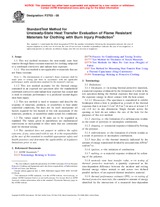We need your consent to use the individual data so that you can see information about your interests, among other things. Click "OK" to give your consent.
ASTM F2703-08
Standard Test Method for Unsteady-State Heat Transfer Evaluation of Flame Resistant Materials for Clothing with Burn Injury Prediction
STANDARD published on 1.7.2008
The information about the standard:
Designation standards: ASTM F2703-08
Note: WITHDRAWN
Publication date standards: 1.7.2008
SKU: NS-54404
The number of pages: 16
Approximate weight : 48 g (0.11 lbs)
Country: American technical standard
Category: Technical standards ASTM
Annotation of standard text ASTM F2703-08 :
Keywords:
apparel, protective clothing, thermal heat protection, thermal performance estimate, flame resistance, ICS Number Code 13.340.10 (Protective clothing)
Additional information
| Significance and Use | ||||||||||||
|
This test method is intended for the determination of a thermal performance estimate value of a material, a combination of materials, or a comparison of different materials used in flame resistant clothing for workers exposed to combined convective and radiant thermal hazards. This test method evaluates a material’s heat transfer properties when exposed to a heat exposure at a constant value and specific duration. Air movement at the face of the specimen and around the calorimeter can affect the measured heat transferred due to forced convective heat losses. Minimizing air movement around the specimen and test apparatus will aid in the repeatability of the results. This test method accounts for the thermal energy stored in the exposed test specimen after the heat exposure has ceased. Higher values of Thermal Performance Estimate ratings determined in this test associate to higher values of thermal (convective and radiative) energy protection against a predicted skin burn injury. This test method maintains the specimen in a static, horizontal position and does not involve movement except that resulting from the exposure. This test method specifies a standardized 84 ± 2 kW/m2 (2 ± 0.05 cal/cm2s) exposure condition. Different exposure conditions have the potential to produce different results. Other exposure conditions representative of the expected hazard are allowed but shall be reported with the results along with a determination of the exposure energy level stability. This test method contains optional provisions for conducting certification testing against a prescribed Thermal Performance Estimate value. |
||||||||||||
| 1. Scope | ||||||||||||
|
1.1 This test method measures the non-steady state heat transfer through flame resistant materials for clothing subjected to a combined convective and radiant heat exposure. 1.1.1 This test method is not applicable to materials that are not flame resistant. Note 1—The determination of a material’s flame resistance shall be made prior to testing and done in accordance with the applicable performance and/or specification standard for the material’s end-use. 1.1.2 This test method accounts for the thermal energy contained in an exposed test specimen after the standardized combined convective and radiant heat exposure has ceased and is used to estimate performance to a predicted second-degree skin burn injury. 1.2 This test method is used to measure and describe the response of materials, products, or assemblies to heat under controlled conditions, but does not by itself incorporate all factors required for fire hazard or fire risk assessment of the materials, products, or assemblies under actual fire conditions. 1.3 The values stated in SI units are to be regarded as standard. The values given in parentheses are mathematical conversions to inch-pound or other units that are commonly used for thermal testing. 1.4 This standard does not purport to address the safety concerns, if any, associated with its use. It is the responsibility of the user of this standard to establish appropriate safety and health practices and determine the applicability of regulatory limitations prior to use. |
||||||||||||
| 2. Referenced Documents | ||||||||||||
|



 Cookies
Cookies
